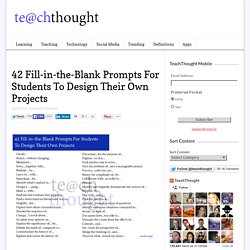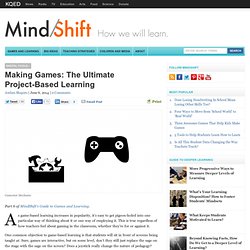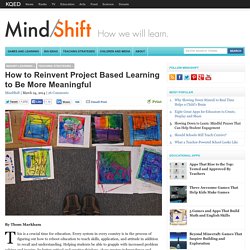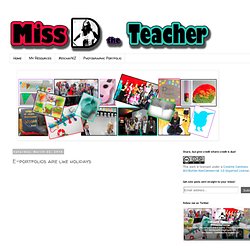

Problem-Based Learning. What is Problem-Based Learning Problem-based learning (PBL) challenges students to identify and examine real problems, then work together to address and solve those problems through advocacy and by mobilizing resources.

Importantly, every aspect of the problem solving process involves students in real work—work that is a reflection of the range of expertise required to solve issues in the world outside of school. While problem-based learning can use any type of problem as its basis, the approach described here is deliberately focused on local ones. Local problems allow students to have a meaningful voice, and be instrumental in a process where real, recognizable change results. It also gives students opportunities to source and interact with a variety of local experts. Back to School Thoughts on Designing Good Learning - Pondering Good Learning. After a bit of reflection and professional reading over the holidays, here is what I want each and every lesson / experience / sequence of learning I facilitate to include.

They are my Rules of Thumb for Designing Good Learning Experiences, circa early 2015. My role then changes to: “a stream of highly contingent, situation, problem and person-specific interventions and provocations – not nuggets of truth” – ClaxtonPushing, prodding, tilting towards understandingProviding the knowledge or guidance needed at that timeQuestioning, facilitating discussionsProviding EXCELLENT feedback based on content, understandings, AND dispositionsTracking quality learning, ensuring engagement. Following up / chasing up.Modelling good thinking and learning dispositions. 42 Fill-in-the-Blank Prompts For Students To Design Their Own Projects.
42 Fill-in-the-Blank Prompts For Students To Design Their Own Projects by Terry Heick So often, we make learning more complicated than it has to be.

Local planning requirements are usually at fault here–plan this way and prove that you’ve done so here and here, fill out this and this, etc. Those legitimate concerns aside, the following series of fill-in-the-blank prompts can be used by teachers to create lessons, students to create projects–or teachers to collaborate with students to create lessons–or projects. Or, well, you get the idea. Please steal them, add to them, or otherwise do with them what you will. Education Week. Making Games: The Ultimate Project-Based Learning. Gamestar Mechanic Part 6 of MindShift’s Guide to Games and Learning.

As game-based learning increases in popularity, it’s easy to get pigeon-holed into one particular way of thinking about it or one way of employing it. This is true regardless of how teachers feel about gaming in the classroom, whether they’re for or against it. One common objection to game-based learning is that students will sit in front of screens being taught at. Sure, games are interactive, but on some level, don’t they still just replace the sage on the stage with the sage on the screen? In previous posts in this series, I’ve argued that because games involve systems thinking, they contextualize learning. “Games are just simulators with an internal incentive structure (often dopamine based). However, virtual simulations of hands-on experience are not the same as tangibly engaging with the world. Fortunately, few people are calling for games to replace school as we know it. How to Reinvent Project Based Learning to Be More Meaningful.
By Thom Markham This is a crucial time for education.

Every system in every country is in the process of figuring out how to reboot education to teach skills, application, and attitude in addition to recall and understanding. Helping students be able to grapple with increased problem solving and inquiry, be better critical and creative thinkers, show greater independence and engagement, and exhibit skills as presenters and collaborators is the challenge of the moment. That’s why so many educators are using the project based learning (PBL) model. PBL has proven to be a means for setting up the kind of problem-solving challenges that engage students in deeper learning and critical inquiry. However, it’s also time to reboot PBL. If PBL is to become a powerful, accepted model of instruction in the future, a vocabulary change may be in order — preferably to the term project based inquiry. 1.
First, think skills. Think strategically. Use PBL for entrepreneurial inquiry. 2. Let go of theory. Teaching and E-learning. Taking risks. What happens when 5th graders run the classroom: A SOLE in action. Two students in Mr.

J’s class laugh as they teach themselves about Mercy Otis Warren and the American Revolution. Photo: Natasha Scripture Eleven-year-olds running a classroom? That could sound outlandish to some elementary school teachers, but not to Joe Jamison, or “Mr. J” as he is affectionately called by his fifth-grade students at Lawrence Intermediate School in central New Jersey. “I learn from my kids,” says Mr. There is a feeling of excitement in the small classroom, decorated with inspirational quotes and bright educational paraphernalia.
This activity is part of Mr. More from the TED Prize Blog: Karachi’s youth paint “pictures of peace” “The biggest thing for me is to prepare my students for the real world, to teach them essential skills such as critical thinking,” says Mr. Mr. Mr. His students are flexible and receptive to working in different ways. Hadi, 11, also enjoys SOLE sessions. Mr. More from the TED Prize Blog: Calling documentary filmmakers… Leading-and-managing-complex-change1. Guide to Developing Good Questions. This question development guide was one first developed in a previous school which I have updated recently.

The Word version of this is formatted nicely but this gives a good idea of how it works: Brainstorm of your early ideas Questions/topics/areas/issues related to theme that you may be interested in developing further Relevance of your topic What big ideas and/or concepts will I learn about from doing this topic? How do my ideas for an inquiry so far relate to what we have been doing in class? Developing good inquiry questions There are two main types of questions: Questions which require you to simply gather information.Questions which require you to make a reasoned judgement about information.
Here are some examples of the two types of question: Now that you have brainstormed some ideas, what is your final choice of a topic? What is the inquiry question you will use to explore this topic? To ensure you have a powerful inquiry question, use the following criteria: Yes (continue) No (continue) Miss D the Teacher: E-portfolios are like holidays. I spend a lot of my time thinking, learning, teaching and reading about e-learning, and lately, a lot of this time has been focussing on e-portfolios.

Although the concept of a portfolio is not new, the e-portfolio has become increasingly trendy of late. However, personally I hope that e-portfolios transcend trend and make their way into the realm of common practice. Personally, I think the biggest value in e-portfolios lie in that they exemplify the learning progress. Learning is not a destination, it is a journey. After all, why do people go on holiday? At Hobsonville Point Secondary School, we will be using e-portfolios with both staff and students. Our students will also have e-portfolios. Rubric.pdf.